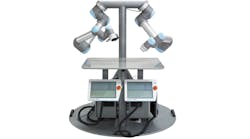Thomas Visti, vice president of Denmark's Universal Robots, was hit head-on by his company's signature UR5 robot at least 20 times during its North American debut this year. There were no fences present to protect him and no gear to soften the blows, but Visti would not have so much as a bruise the next day to show for it.
The crowd, however -- many of whom had taken turns programming the robotic arm's path on its tablet-style controller -- were much more permanently impressed. And that was exactly the effect Visti was after as he stepped in the way of the swinging robotic arm time after time.
See Also: Manufacturing Industry Technology News & Trends
On this side of the recession, robots have become a fairly common sight in factories across the U.S. According to the Robotic Industries Association (RIA), there are some 225,000 robots at work in U.S. factories today, putting the nation second only to Japan in terms of robot usage. However, this number represents only a fraction of the total possible market.
"Many observers believe that only about 10% of the U.S. companies that could benefit from robots have installed any so far," RIA's President, Jeff Burnstein notes. "Among those that have the most to gain from robots are small and medium-sized companies."
That market, says Visti, is exactly where Universal Robots is aiming.
"It's been known for many years that these smaller companies have demands for automation in general and also for robots, but no one has really had a final product for them," he says. "The whole idea of developing this company was to look at the demands of those companies and develop a robot to meet them."
What he found from these companies, he says, was the need for flexible robots that are easy to program and that can work side-by-side with workers without the need for fencing -- objectives throwing himself in front of his quickly-programmed robots amply proved.
Scaling Back the Wishlist
According to Manfred Gundel, CEO of KUKA Robotics, "To encourage 'unexperienced' small and medium-sized companies to invest in automation, they need solutions which are on the one hand 'easy to use' but on the other hand also flexible, fast, precise and energy-saving to ensure the increase of production on high-level quality."
Coming from a large manufacturing perspective, this is no easy task to fill. Bringing the high-speed, articulate work of automotive robots to the small shops -- and doing so in a safe, fence-free manner -- requires significant technology advances that are still years off.
As Visti explains, "It is very difficult to develop a very simple robot if you have a wishlist with more than 100 kinds of features that you want the robot to do." Universal Robots, however, bypassed that difficulty by scaling back that wishlist to the basic functions small and mid-sized companies most frequently require.
"If we can meet just 80% of those applications," he says, "that is good enough for us and it is 99% good enough for the small and medium-sized customers."
In that respect, he says that his company is creating a new niche in the robotics market: a new kind of simple-to-use, safe robots for these underserved manufacturers.
"The robots we have been selling are not taking market shares away from traditional robots," he says. "Instead, we are starting up all new markets."
This, he says, is what the company's robots have provided small and medium sized manufacturing enterprises across Europe and China since 2009 and what it plans to bring to the U.S. as it enters the market this year.





